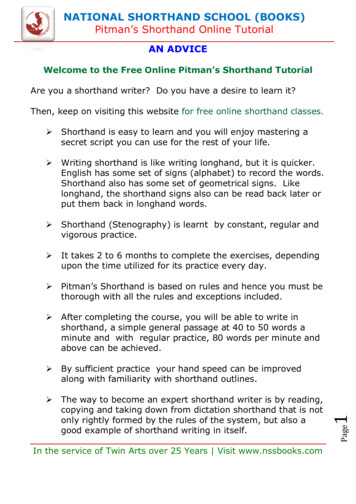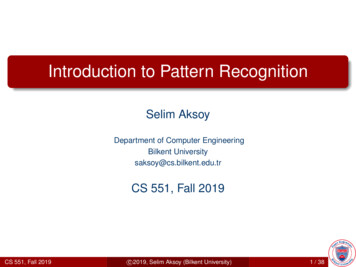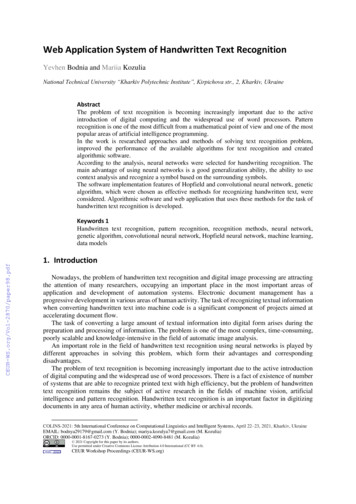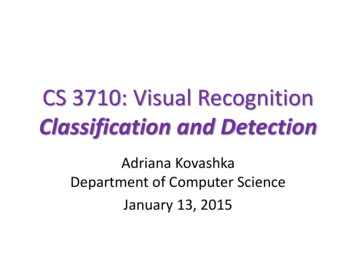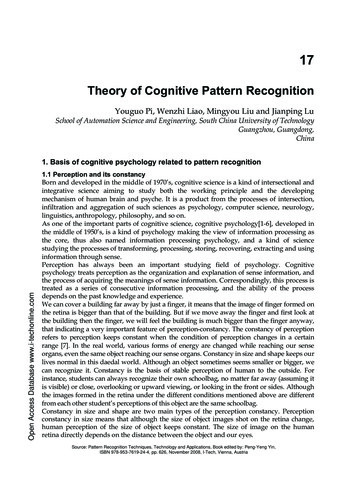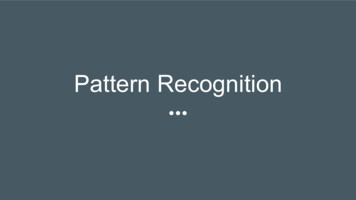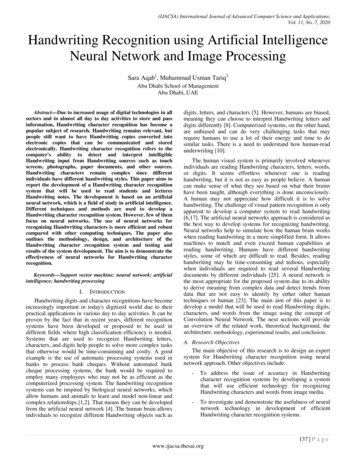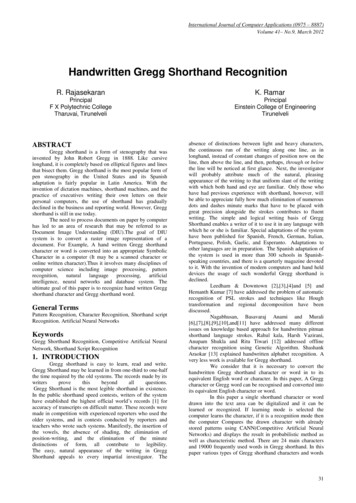
Transcription
International Journal of Computer Applications (0975 – 8887)Volume 41– No.9, March 2012Handwritten Gregg Shorthand RecognitionR. RajasekaranPrincipalF X Polytechnic CollegeTharuvai, TirunelveliABSTRACTGregg shorthand is a form of stenography that wasinvented by John Robert Gregg in 1888. Like cursivelonghand, it is completely based on elliptical figures and linesthat bisect them. Gregg shorthand is the most popular form ofpen stenography in the United States and its Spanishadaptation is fairly popular in Latin America. With theinvention of dictation machines, shorthand machines, and thepractice of executives writing their own letters on theirpersonal computers, the use of shorthand has graduallydeclined in the business and reporting world. However, Greggshorthand is still in use today.The need to process documents on paper by computerhas led to an area of research that may be referred to asDocument Image Understanding (DIU).The goal of DIUsystem is to convert a raster image representation of adocument. For Example, A hand written Gregg shorthandcharacter or word is converted into an appropriate SymbolicCharacter in a computer (It may be a scanned character oronline written character).Thus it involves many disciplines ofcomputer science including image processing, patternrecognition, natural languageprocessing, artificialintelligence, neural networks and database system. Theultimate goal of this paper is to recognize hand written Greggshorthand character and Gregg shorthand word.General TermsPattern Recognition, Character Recognition, Shorthand scriptRecognition. Artificial Neural NetworksKeywordsGregg Shorthand Recognition, Competitive Artificial NeuralNetwork, Shorthand Script Recognition1. INTRODUCTIONGregg shorthand is easy to learn, read and write.Gregg Shorthand may be learned in from one-third to one-halfthe time required by the old systems. The records made by itswritersprovethisbeyondallquestions.Gregg Shorthand is the most legible shorthand in existence.In the public shorthand speed contests, writers of the systemhave established the highest official world’s records [1] foraccuracy of transcripts on difficult matter. These records weremade in competition with experienced reporters who used theolder systems, and in contests conducted by reporters andteachers who wrote such systems. Manifestly, the insertion ofthe vowels, the absence of shading, the elimination ofposition-writing, and the elimination of the minutedistinctions of form, all contribute to legibility.The easy, natural appearance of the writing in GreggShorthand appeals to every impartial investigator. TheK. RamarPrincipalEinstein College of EngineeringTirunelveliabsence of distinctions between light and heavy characters,the continuous run of the writing along one line, as inlonghand, instead of constant changes of position now on theline, then above the line, and then, perhaps, through or belowthe line will be noticed at first glance. Next, the investigatorwill probably attribute much of the natural, pleasingappearance of the writing to that uniform slant of the writingwith which both hand and eye are familiar. Only those whohave had previous experience with shorthand, however, willbe able to appreciate fully how much elimination of numerousdots and dashes minute marks that have to be placed withgreat precision alongside the strokes contributes to fluentwriting. The simple and logical writing basis of GreggShorthand enables a writer of it to use it in any language withwhich he or she is familiar. Special adaptations of the systemhave been published for Spanish, French, German, Italian,Portuguese, Polish, Gaelic, and Esperanto. Adaptations toother languages are in preparation. The Spanish adaptation ofthe system is used in more than 300 schools in Spanishspeaking countries, and there is a quarterly magazine devotedto it. With the invention of modern computers and hand helddevices the usage of such wonderful Gregg shorthand isdeclined.Leedham & Downtown [2],[3],[4]and [5] andHemanth Kumar [7] have addressed the problem of automaticrecognition of PSL strokes and techniques like Houghtransformation and regional decomposition have beendiscussed.Nagabhusan, Basavaraj Anami and Murali[6],[7],[8],[9],[10],and[11] have addressed many differentissues on knowledge based approach for handwritten pitmanshorthand language strokes. Rahul kala, Harsh Vazirani,Anupam Shukla and Ritu Tiwari [12] addressed offlinecharacter recognition using Genetic Algorithm. ShashankAraokar [13] explained handwritten alphabet recognition. Avery less work is available for Gregg shorthand.We consider that it is necessary to convert thehandwritten Gregg shorthand character or word in to itsequivalent English word or character. In this paper, A Greggcharacter or Gregg word can be recognised and converted intoits equivalent English character or word.In this paper a single shorthand character or worddrawn into the text area can be digitalized and it can belearned or recognized. If learning mode is selected thecomputer learns the character, if it is a recognition mode thenthe computer Compares the drawn character with alreadystored patterns using CANN(Competitive Artificial NeuralNetworks) and displays the result in probabilistic method aswell as characteristic method. There are 24 main charactersand 19000 frequently used words in Gregg shorthand. In thispaper various types of Gregg shorthand characters and words31
International Journal of Computer Applications (0975 – 8887)Volume 41– No.9, March 2012are tested and the results were presented. Our future proposalis to recognise and convert all those 19000 frequently usedGregg shorthand words. Recognition rate for online andoffline Gregg shorthand was compared. Efficiency of offlineis better over online.The rest of the paper is organized as follows: Section (2)focuses on Artificial Neural networks and Section (3)emphasizes on HGSR (Handwritten Gregg ShorthandRecognition) algorithm for Gregg shorthand recognition andSection (4) for the Experimental results and conclusion.2. ARTIFICIAL NEURAL NETWORKSThe exact workings of the human brain are still a mystery.Yet, some aspects of this amazing processor are known. Inparticular, the most basic element of the human brain is aspecific type of cell which, unlike the rest of the body, doesn'tappear to regenerate. Because this type of cell is the only partof the body that isn't slowly replaced, it is assumed that thesecells are what provide us with our abilities to remember,think, and apply previous experiences to our every action.These cells, all 100 billion of them, are known as neurons.Each of these neurons can connect with up to 200,000 otherneurons, although 1,000 to 10,000 are typical.The power of the human mind comes from the sheernumbers of these basic components and the multipleconnections between them. It also comes from geneticprogramming and learning. The individual neurons arecomplicated. They have a myriad of parts, sub-systems, andcontrol mechanisms. They convey information via a host ofelectrochemical pathways. There are over one hundreddifferent classes of neurons, depending on the classificationmethod used. Together these neurons and their connectionsform a process which is not binary, not stable, and notsynchronous. In short, it is nothing like the currently availableelectronic computers, or even artificial neural networks. Theseartificial neural networks try to replicate only the most basicelements of this complicated, versatile, and powerfulorganism. They do it in a primitive way. But for the softwareengineer who is trying to solve problems, neural computingwas never about replicating human brains. It is aboutmachines and a new way to solve problems.On the contrary, neural network researchers areseeking an understanding of nature's capabilities for whichpeople can engineer solutions to problems that have not beensolved by traditional computing.To do this, the basic unit of neural networks, theartificial neurons, simulates the four basic functions of naturalneurons. Figure 1 shows a fundamental representation of anartificial neuron.Figure 1 A Basic Artificial Neuron.In Figure 1, various inputs to the network arerepresented by the mathematical symbol, x(n). Each of theseinputs are multiplied by a connection weight. These weightsare represented by w(n). In the simplest case, these productsare simply summed, fed through a transfer function togenerate a result, and then output. This process lends itself tophysical implementation on a large scale in a small package.This electronic implementation is still possible with othernetwork structures which utilize different summing functionsas well as different transfer functions.Some applications require "black and white," orbinary, answers. These applications include the recognition oftext, the identification of speech, and the image deciphering ofscenes. These applications are required to turn real-worldinputs into discrete values. These potential values are limitedto some known set, like the ASCII characters or the mostcommon 50,000 English words. Because of this limitation ofoutput options, these applications don't always utilizenetworks composed of neurons that simply sum up, andthereby smooth, inputs. These networks may utilize the binaryproperties of ORing and ANDing of inputs. These functions,and many others, can be built into the summation and transferfunctions of a network.Other networks work on problems where theresolutions are not just one of several known values. Thesenetworks need to be capable of an infinite number ofresponses. Applications of this type include the "intelligence"behind robotic movements. This "intelligence" processesinputs and then creates outputs which actually cause somedevice to move. That movement can span an infinite numberof very precise motions. These networks do indeed want tosmooth their inputs which, due to limitations of sensors, comein non-continuous bursts, say thirty times a second. To dothat, they might accept these inputs, sum that data, and thenproduce an output by, for example, applying a hyperbolictangent as a transfer functions. In this manner, output valuesfrom the network are continuous and satisfy more real worldinterfaces.Other applications might simply sum and compareto a threshold, thereby producing one of two possible outputs,a zero or a one. Other functions scale the outputs to match theapplication, such as the values minus one and one. Somefunctions even integrate the input data over time, creatingtime-dependent networks.Once a network has been structured for a particularapplication, that network is ready to be trained. To start thisprocess the initial weights are chosen randomly. Then, thetraining, or learning, begins.There are two approaches to training - supervisedand unsupervised. Supervised training involves a mechanismof providing the network with the desired output either bymanually "grading" the network's performance or byproviding the desired outputs with the inputs. Unsupervisedtraining is where the network has to make sense of the inputswithout outside help.The vast bulk of networks utilize supervisedtraining. Unsupervised training is used to perform some initialcharacterization on inputs. However, in the full blown senseof being truly self learning, it is still just a shining promisethat is not fully understood, does not completely work, andthus is relegated to the lab.In supervised training, both the inputs and theoutputs are provided. The network then processes the inputsand compares its resulting outputs against the desired outputs.Errors are then propagated back through the system, causingthe system to adjust the weights which control the network.32
International Journal of Computer Applications (0975 – 8887)Volume 41– No.9, March 2012This process occurs over and over as the weights arecontinually tweaked. The set of data which enables thetraining is called the "training set." During the training of anetwork the same set of data is processed many times as theconnection weights are ever refined.The other type of training is called unsupervisedtraining. In unsupervised training, the network is providedwith inputs but not with desired outputs. The system itselfmust then decide what features it will use to group the inputdata. This is often referred to as self-organization or adoption.At the present time, unsupervised learning is not wellunderstood. This adoption to the environment is the promisewhich would enable science fiction types of robots tocontinually learn on their own as they encounter newsituations and new environments.This paper illustrates both supervised andunsupervised learning mechanisms of Gregg shorthandrecognition.The strategy used for recognition can be broadly classifiedinto three categories, namely: structural, statistical and hybrid.Structural techniques use some qualitative measurements asfeatures. They employ different methods such as rule-based,graph-theoretic and heuristic methods for classification.Statistical techniques use some quantitative measurements asfeatures and an appropriate statistical method for recognition.In hybrid approach, these two techniques are combined atappropriate stages for representation of characters andutilizing them for recognition. Depending on the problem,anyone of these techniques can be utilized whileaccommodating the variations in handwriting.3.2 Description of AlgorithmHandwritten Gregg Shorthand character or word3. HGSR ALGORITHM3.1 Existing SystemThe recognition of characters from scanned images ofdocuments has been a problem that has received muchattention in the fields of image processing, pattern recognitionand artificial intelligence.Classical methods in pattern recognition do not assuch suffice for the recognition of visual characters due to thefollowing reasons:1. The ‘same’ characters differ in sizes, shapes and stylesfrom person to person and even from time to time with thesame person.2. Like any image, visual characters are subject to spoilagedue to noise.3. There are no hard-and-fast rules that define the appearanceof a visual character. Hence rules need to be heuristicallydeduced from samples.As such, the human system of vision is excellent inthe sense of the following qualities:1. The human brain is adaptive to minor changes and errors invisual patterns. Thus we are able to read the handwritings ofmany people despite different styles of writing.2. The human vision system learns from experience: Hencewe are able to grasp newer styles and scripts with amazinglyhigh speed.3. The human vision system is immune to most variations ofsize, aspect ratio, color, location and orientation of visualcharacters.In contrast to limitations of classical computing,Artificial Neural Networks (ANNs), that were first developedin the mid 1900’s serve for the emulation of human thinkingin computation to a meager, yet appreciable extent. Of theseveral fields wherein they have been applied, humanoidcomputing in general and pattern recognition in particularhave been of increasing activity. The recognition of visual(optical) characters is a problem of relatively amenablecomplexity when compared with greater challenges such asrecognition of human faces. ANNs have enjoyed considerablesuccess in this area due to their humanoid qualities such asadapting to changes and learning from prior experience. Sowe have decided to take this ANN for this paper.Preprocessing AlgorithmDigitization AlgorithmLearning nt English Character or wordFigure 2 Block Diagram of HGSR AlgorithmBlock diagram of Handwritten Gregg Shorthand RecognitionAlgorithm is as above. Handwritten Gregg shorthand imagewas taken as an input (offline or online).Preprocessingalgorithm performs all the filtering; Normalization operations.Digitization algorithm performs character digitizationoperation. Learning algorithm performs learning of newGregg character or word either in supervised mode orunsupervised mode. Validation algorithm compares the inputGregg character with already trained set of Gregg charactersor words and produced the result possibilities in percentage.This HGSR algorithm is a combination of all the above subalgorithms.a) Preprocessing AlgorithmGregg shorthand Image is given as an input to thisalgorithm. It performs filtering operations, normalizingoperations, resizing operations etc. The output image can besaved and given as an input to Digitizing algorithm.Begin preprocessStep1: The Gregg character offline is taken as an input(Image)Step2: Image size is determinedStep3: Filtering can be applied based on the need of the imageeither it can be applied for softening, or sharpeningor embossing, normalizing etc.33
International Journal of Computer Applications (0975 – 8887)Volume 41– No.9, March 2012Step4: Save the imageEnd preprocessb) Digitization algorithmPreprocessed image or a normal Gregg shorthand imagecan be given as an input to this algorithm. Output of thisalgorithm is given as an input to Recognition or LearningAlgorithm.Begin digitizeStep1: The Gregg offline /online character is given as an inputand the size of the grid is selected based on the need ofaccuracy.Step2: Image is raster scanned block by block and identifiesthe left borderStep3: Scans the image and identifies the right borderStep4: Scans the image and identifies the top borderStep5: Scans the image and identifies the bottom borderStep6: Calculate width and Height of the imageStep7: Calculate whether the drawn Gregg character is talland skinny or short and fat and the location where theshorthand image is available in the text area.Step8: Scans the image from the detected boundary from left,to rightStep9: if block1 (black) then fix Grid1 (black)Step10: Repeat step9 until the entire boundary scans completeStep11: Get the digitized image of the drawn (or offline)shorthand characterEnd digitizeThe following Figure 3(a) and (b) shows the output ofdigitization algorithm.(a)(b)(c)Figure 4.a) Binary digitized input Matrix Ib. Gregg matrix Gc) Learning AlgorithmThis algorithm is used to train the neural network eitherin supervised mode or unsupervised mode. In supervisedtraining, both the inputs and the outputs are provided. InUnsupervised Training, the network is provided with inputsbut not with desired outputs. The system itself must thendecide what features it will use to group the input data.Begin learningStep1: New character or word to be learned is taken as anInputStep2: if learning (supervised)Figure 3 (a)(b)(a) Offline Gregg Character „a‟ and its digitization(b) Online Gregg word „aback‟ and its digitizationIn the digitization process, the input image is sampled into abinary window which forms the input to the recognitionsystem. In the above figure, the alphabet ‘a’ has been digitizedinto 6X8 48 digital cells, each having a single color, eitherblack or white. It becomes important for us to encode thisinformation in a form meaningful to a computer. For this, weassign a value 1 to each black pixel and 0 to each whitepixel and create the binary image matrix I which is shown inthe figure 4.Begin supervisedStep1: Add the new character name into the neural netFileStep2: Save the name of the new character into theNeural netStep3: learning is applied to the new character in theNeural netStep4: Repeat step3 until learning completes.Step5: The network then processes the inputs andCompares its resulting output against the desiredoutput.Step6: Learning result is stored into the neural net file.End supervisedStep3: if learning (unsupervised)Begin unsupervisedStep1: create limit percentage is given as an inputStep2: If the best recognition is below the create limitpercentage then a new character will be created.Step3: learn limit percentage is given as an inputStep4: If the best recognition is above that percentagethen learning will take place on that character.Step5: Repeat step4 until learning completes.Step6: Learning result is stored into the neural net file.End unsupervisedStep4: Repeat step2, step3 until learning completes.End learning34
International Journal of Computer Applications (0975 – 8887)Volume 41– No.9, March 2012d)the best match) is considered the winner.Step16: The output was produced to all the possibleProbabilistic percentage of all the character available inthe character netRecognition algorithmInput Gregg Binary matrix I3.3 Performance AnalysisGregg matrix GWeight matrix WANN ValidatorOutputBest recognitionCharacter orWordFigure 5 Block diagram of recognition algorithmabFigure 7 a. Weight Matrix W for Character „a‟b.Weight Matrix W for Character „aback‟This algorithm is used to recognize the Gregg characterBegin RecognitionStep1: Digitized Gregg character matrix ‘I’ is given as aninputStep2: Scan each and every element of the matrix IStep3: Create a matrix G then copy all the elements of I andreplace the value ‘0’ with ‘-1’If I (i, j) 1Then G(i, j) 1Else:If I (i, j) 0 Then G(i, j) -1Step4: The input matrix G is now fed as input to the neuralnetwork.Step5: It is typical for any neural network to learn in asupervised or unsupervised manner by adjusting itsweights.Step6: For the kth character to be taught to the network, theweight matrix is formed and denoted by Wk.Step7: At the commencement of teaching (supervisedtraining), this weight matrix is initialized to zero.Step8: Whenever a character is to be taught to the network, aninput pattern representing that character is submittedto the network.Step9: The network is then instructed to identify this patternas, say, the kth character in a knowledge base ofcharacters.Step10: The weight matrix Wk is updated in the followingmanner: Wk(i,j) Wk(i,j) G(i,j)Step11: The weight matrix Wk is given as an input to ANNValidatorStep12: ANN Validator compares the weight matrix withalready available neural network character set.Step13: If a link between an input neuron and an outputneuron is positive, that means that if the input is onthen the total score for that output neuron is increasedby a small amount.Step14: If the link is negative, then it follows that if that inputis on, the corresponding output has its score reduced byan amount.Step15: The output neuron with the highest score (and thusFigure. 7 a and b gives the weight matrix, say, „Wa’corresponding to the Gregg alphabet „a‟. and thecorresponding weight matrix „Waback‟ for the Greggword „aback‟ The matrix has been updated thrice to learnthe alphabet „a‟ so the value is 3 and -3. It should be notedthat this matrix is specific to the alphabet „a‟ alone. Othercharacters shall each have a corresponding weight matrix.Figure 8 Recognition of Gregg character „a‟In the above figure 8 the adaptive performance of the networkcan easily be tested by an example: Gregg character ‘a’, andby giving repeated learning to the neural network we can getup to 100% recognition result.Figure 9 Recognition of Gregg character „ch‟35
International Journal of Computer Applications (0975 – 8887)Volume 41– No.9, March 2012The neural system has some direct advantages that becomeapparent at this stage:1. The method is highly adaptive; recognition is tolerant tominor errors and changes in patterns.2. The knowledge base of the system can be modified byteaching it newer characters or teaching different variants ofearlier characters.3. The system is highly general and is invariant to size andaspect ratio.4. The system can be made user specific: User-profiles ofcharacters can be maintained, and the system can be made torecognize them as per the orientation of the user.The dimensions of the input matrix need to beadjusted for performance. Greater dimensions, higher theresolution and better the recognition. This however Increasethe time-complexity of the system which can be a sensitiveissue with slower computers. Typically, 32X32 matrices havebeen empirically found sufficient for the recognition of Gregghandwritten characters. For Intricate scripts, greater resolutionof the matrices is required.As already illustrated in the previous example,efficient supervised teaching is essential for the properperformance. Neural expert systems are therefore typicallyused where human-centered training is preferred against rigidand inflexible 6100l7100578m6100568n81006564. EXPERIMENT RESULTSng610066724 Gregg alphabet characters and 3 sample frequently usedwords were taken for this 83t7100772TABLE 1.Comparision Between Recognition Of OfflineRECOGNITIONQUOTIENT IN %TIME IN msONLINE RECOGNITIONRECOGNITIONQUOTIENT IN %TIME IN msOFFLINE RECOGNITIONENGLISH ALPHABETSYMBOLGREGG ALPHABET& Online Gregg Alphabet 72u6100868e6100761v7100767f610068336
International Journal of Computer Applications (0975 – 8887)Volume 41– No.9, March 2012Findings:1Recognition time of Gregg characters or Greggword for both online or offline is more or less same.2Algorithm gives 100% accuracy for offlinecharacters or words3Algorithm gives an average result of 73%recognition quotient Q accuracy for onlinecharacters or words.4If the user drawn character size varies Recognitionquotient Q for online characters also varies.5Online recognition accuracy may come to 100% bygiving proper learning either supervised orunsupervised to the network.5. REFERENCES[1] About Gregg shorthand’s history and world 2] Leedham C G, Downtown A C 1984 On-line recognitionof short forms in Pitmans’ handwritten shorthand. Proc.7th Int. Conf. on Pattern Recognition, Montreal, pp2.1058–2.1060[3] Leedham C G, Downtown A C 1986 On-line recognitionof Pitmans’ handwritten shorthand – An evaluationpotential. Int. J. Man-Machine Studies 24: 375–393[4] Leedham C G, Downtown A C 1987 Automaticrecognition and transcription of Pitman’s handwrittenshorthand - An approach to short forms. Pattern Recogn.20: 341–348[5] Leedham C G, Downtown A C 1990 Automaticrecognition and transcription of Pitman’s handwrittenshorthand. Computer processing of handwriting (eds) RPlamondon, C G Leedham (Singapore:World Scientific)[6] Leedham C G, Downtown A C, Brooks C P, Newell A F1984 On-line acquisition of Pitman’s handwrittenshorthand as a means of rapid data entry. Proc. Int. Conf.on Human-Computer Interaction,Figure 10 Recognition of Gregg word “abduction”abductionenableaback6810010069IN msRECOGNITIONQUOTIENT IN %ONLINE6RECOGNITION TIMEIN msRECOGNITION100QUOTIENT IN %OFFLINE7RECOGNITION TIMEENGLISH WORDSYMBOLGREGG ALPHABETTable2.Comparision Between Recognition Of Offline& Online Gregg Frequently Used Words797864[7] Hemanth Kumar G 1998 Automation of text productionfrom Pitman shorthand notes. Ph D thesis,University ofMysore, Mysore[8] Nagabhushan P, Anami B S 1999 A knowledge basedapproach for composing English text fromphonetic textdocumented through Pitman shorthand language. Int.Conf. On Computer Science (ICCS-99), New Delhi, pp318–327[9] Nagabhushan P, Anami B S 2000 A knowledge basedapproach for recognition of grammalogues andpunctuation symbols useful in automatic English textgeneration from Pitman shorthand language documents.Proc. Natl. Conf. on Recent Trends in AdvancedComputing (NCRTAC-2000),Thirunelveli, pp 175–183[10] Nagabhushan P, Murli 2000 Tangent feature values andcornarity index to recognise handwritten PSL words.Proc. Natl. Conf. on Document Analysis and Recognition(NCDAR), Mandya, India,pp 49–56[11] Nagabhushan P, Anami A knowledge-based approach forrecognition of handwritten Pitman shorthand languagestrokes[12] Rahul kala, Harsh Vazirani, Anupam Shukla and RituTiwari offline character recognition using GeniticAlgorithm IJCSI International Journal of ComputerScience Issues, March 2010 pp 16-25A simplistic approach for recognition of Gregg charactersusing artificial neural networks has been described. Theadvantages of neural computing over classical methods havebeen outlined. Despite the computational complexityinvolved, artificial neural networks offer several advantages inpattern recognition & classification in the sense of emulatingadaptive human intelligence to a small extent. Our Futurework is to recognise rest of 19000 frequently used words ofGregg shorthand.[13] Shashank Araokar Visual Character Recognition usingArtificial Neural Networks[14] Anil K. Jain, Jianchang Mao, K. M. Mohiuddin,Artificial Neural Networks: A Tutorial, Computer,v.29 n.3, p.31-44, March 1996[15] Simon Haykin, Neural Networks: A comprehensivefoundation, 2nd Edition, Prentice Hall, 199837
International Journal of Computer Applications (0975 – 8887)Volume 41– No.9, March 2012[16] Alexander J. Faaborg, Using Neural Networks toCreate an Adaptive Character Recognition / faabor/research/[21] Licolinet, Eric, and Olivier Baret. "Cursive WordRecognition: Methods and Strategies." Fundamentals inat:cornell/hci neuralnet work finalPaper.pdf[17] E. W. Brown, Character Recognition by Feature PointExtraction, unpublished paper authored at .ccs.neu.edu/home/feneric/charrecnn.html[18] Dori, Dov, and Alfred Bruckstein, ed. Shape, StructureHandwriting Recognition”. Ed. Sebastiano Impedovo.New-York: Springer-Verlag, 1994.[22] Simon, J.C. "On the Robustness of Recognition ofDegraded Line Images." Fundamentals in HandwritingRecognition”. Ed. Sebastiano Impedovo. New-York:Springer-Verlag, 1994.[23] Wang, Patrick Shen-Pei. "Learning, Representation,and Pattern Recognition. New Jersey: World ScientificUnderstanding and Recognition of Words - An IntelligentPublishing Co., 1995.Approach." Fundamentals in Handwriting Recognition.[19] Gorsky, N.D. "Off-line Recognition of Bad QualityHandwritten Words Using Prototypes." Fundamentals inHandwriting Recognition. Ed. Sebastiano Impedovo.New-York: Springer-Verlag, 1994.[20] Impedovo, Sebastiano. "Frontiers in HandwritingRecognition." Fu
Gregg shorthand is easy to learn, read and write. Gregg Shorthand may be learned in from one-third to one-half the time required by the old systems. The records made by its writers prove this beyond all questions. Gregg Shorthand is the most legible shorthand in existence. In t
